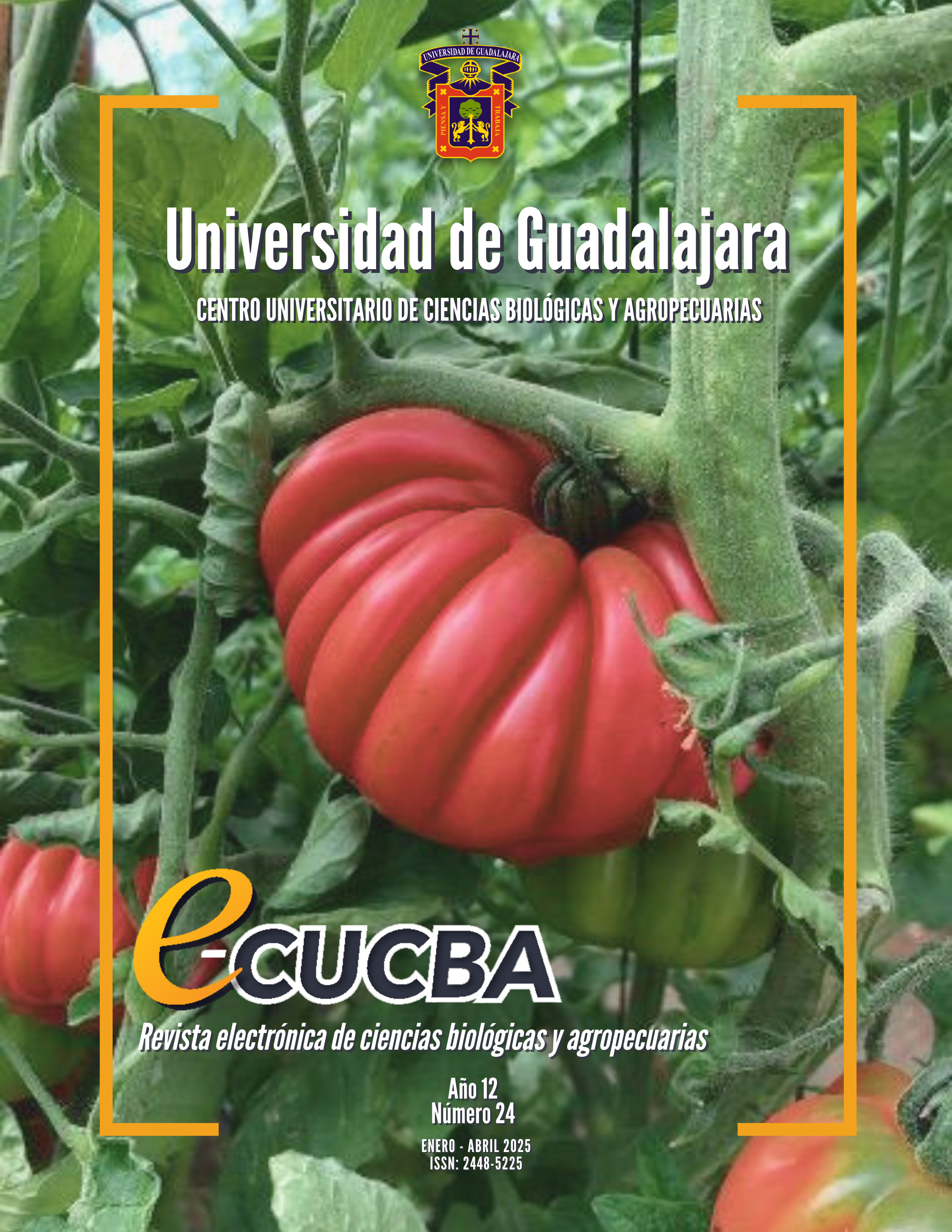Investigación sobre las preferencias en el consumo de insectos
Research on preferences in the consumption of insects
DOI:
https://doi.org/10.32870/e-cucba.vi24.372Keywords:
Entomophagy, culinary traditionsAbstract
Entomophagy, despite its nutritional and ecological benefits, remains poorly accepted among Mexican consumers. There is a gap between the recognition of the advantages of insects as a source of protein and the willingness to incorporate them into the daily diet. This study examined the perception and willingness to consume insects as a protein source. Through surveys of 181 people in Mexico, it was found that, although the majority consider that the consumption of insects does not represent a health risk, the appearance of insects is the main barrier to consuming them, especially among women. Respondents showed a greater willingness to consume insects in processed forms, such as canned or fermented, that disguise their appearance. However, those with higher levels of neophobia and sensitivity to disgust are less likely to accept its consumption, despite knowing its benefits. These results highlight the discrepancy between accepting insects as a protein alternative and the true willingness to buy and eat them.
References
Avendaño, C., Sánchez, M. y Valenzuela, C. (2020). Insectos: son realmente una alternativa para la alimentación de animales y humanos. Revista chilena de nutrición, 47, 1029-1037. http://dx.doi.org/10.4067/S0717-75182020000601029
Bisconsin-Júnior A., Rodrigues H., Behrens H. J., Azevedo P. M. A., B. y R., M. L. (2022). “Food made with edible insects”: Exploring the social representation of entomophagy where it is unfamiliar. Appetite, 173, 106001. https://doi.org/10.1016/j.appet.2022.106001
Authorising the placing on the market of the frozen, paste, dried and powder forms of Alphitobius diaperinus larvae (lesser mealworm) as a novel food and amending Implementing Regulation (EU) 2017/2470,(2023).
Costa Neto, E. y Ramos-Elorduy, J. (2006). Los insectos comestibles de Brasil: etnicidad, diversidad e importancia en la alimentación. Boletín Sociedad Entomológica Aragonesa, 38, 423-442.
da Silva Lucas, A. J. M. d. O., L., da Rocha, M. y Prentice, C. (2020). Edible insects: An alternative of nutritional, functional and bioactive compounds. Food Chem, 311, 126022. https://doi.org/10.1016/j.foodchem.2019.126022
de Carvalho, N. M., Madureira, A. R. y Pintado, M. E. (2020). The potential of insects as food sources–a review. Critical reviews in food science and nutrition, 60(21), 3642-3652.
Elorduy, J. R., Pino, J. M. y Correa, S. C. (1998). Insectos comestibles del Estado de México y determinación de su valor nutritivo. Anales del Instituto de Biología. Serie Zoología, 69(1), 65-104.
Gahukar, R. T. (2011). Entomophagy and human food security. International Journal of Tropical Insect Science, 31(3), 129-144. https://doi.org/10.1017/S1742758411000257
Hartmann Christina, Shi Jing, Giusto Alice. y Siegrist Michael. (2015). The psychology of eating insects: A cross-cultural comparison between Germany and China. Food Quality and Preference, 44, 148-156. https://doi.org/10.1016/j.foodqual.2015.04.013
Kamenidou, I., Mamalis, S., Gkitsas, S., Mylona, I. y Stavrianea, A. (2023). Is Generation Z Ready to Engage in Entomophagy? A Segmentation Analysis Study. Nutrients, 15(3), 525. https://doi.org/10.3390/nu15030525
Khalil, R., Kallas, Z., Montserrat, P. y Amira, H. (2024). Consumers´ willingness to pay for snacks enriched with insects: A trending and sustainable protein source. Future Foods, 9, 100360. https://doi.org/10.1016/j.fufo.2024.100360
La Barbera, F., Verneau, F., Amato, M., Grunert K. y Schnettler, B. (2021). Acceptance of insect-based food in Chile: Evidence from a survey using the entomophagy attitude questionnaire (EAQ). Food Quality and Preference, 93, 104269. https://doi.org/10.1016/j.foodqual.2021.104269
Mancini, S., Sogari, G., Espinosa Diaz, S., Menozzi, D., Paci, G. y Moruzzo, R. (2022). Exploring the Future of Edible Insects in Europe. Foods, 11(3), 455. https://doi.org/10.3390/foods11030455
Modlinska, K., Adamczyk, D., Maison, D., Goncikowska, K. y Pisula, W. (2021). Relationship between Acceptance of Insects as an Alternative to Meat and Willingness to Consume Insect-Based Food—A Study on a Representative Sample of the Polish Population. Foods, 10(10), 2420.
Nikkhah, A., Van Haute, S., Jovanovic, V., Jung, H., Dewulf, J., Cirkovic Velickovic, T. y Ghnimi, S. (2021). Life cycle assessment of edible insects (Protaetia brevitarsis seulensis larvae) as a future protein and fat source. Scientific Reports, 11(1).
ONU. (2013). Organización de las Naciones Unidas para la Alimentación y la Agricultura destaca el valor nutritivo de los insectos. https://news.un.org/es/story/2013/05/1271801#:~:text=Un%20informe%20de%20la%20FAO,nutritivos%20y%20ricos%20en%20prote%C3%ADnas.
Ramos - Elorduy, J. y Moreno, J. M. P. (1989). Los insectos comestibles en el México antiguo: estudio etnoentomológico. AGT.
Ramos - Elorduy, J., Manuel, P. J. y Mariangela, C. (2006). Ausencia de una reglamentación y normalización de la explotación y comercialización de insectos comestibles en México. Folia Entomológica Mexicana, 45(3), 291-318. https://doi.org/10.1080/03670240701805074
Rivera, J. y Carbonell, F. (2020). Los insectos comestibles del Perú: Biodiversidad y perspectivas de la entomofagia en el contexto peruano. Ciencia & Desarrollo, 27, 5-36. https://doi.org/10.33326/26176033.2020.27.995
Ros-Baró, M., Casas-Agustench, P., Díaz-Rizzolo, D. A., Batlle-Bayer, L., Adrià-Acosta, F., Aguilar-Martínez, A., . . . Bach-Faig, A. (2022). Edible Insect Consumption for Human and Planetary Health: A Systematic Review. International Journal of Environmental Research and Public Health, 19(18), 11653. https://doi.org/10.3390/ijerph191811653
Sogari, G., Bogueva, D. y Marinova, D. (2019). Australian Consumers’ Response to Insects as Food. Agriculture, 9(5), 108. https://doi.org/10.3390/agriculture9050108
van Huis, A. y Oonincx, D. G. A. B. (2017). The environmental sustainability of insects as food and feed. A review. Agronomy for Sustainable Development, 37(5), 43. https://doi.org/10.1007/s13593-017-0452-8
Yüksel, E. y Canhilal, R. (2018). A Survey of Public Opinion about Entomophagy in Erciyes University. Uluslararası Tarım ve Yaban Hayatı Bilimleri Dergisi, 4, 10.24180/ijaws.440555
Downloads
Published
How to Cite
Issue
Section
License
Copyright (c) 2024 Delia Guillermina González-Aguilar, Mitzi Junuee López-López, Jeannette Barba-León, Nils Th. Grabowski-Ommen, Lilia Mercedes Mancilla-Becerra, Luis Eduardo Segura-García

This work is licensed under a Creative Commons Attribution-NonCommercial-NoDerivatives 4.0 International License.






